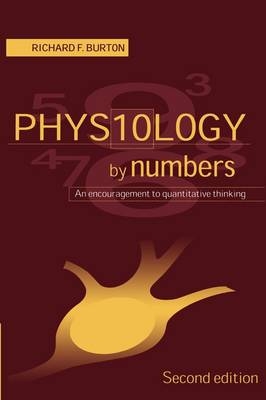
Physiology by Numbers
An Encouragement to Quantitative Thinking
Seiten
2000
|
2nd Revised edition
Cambridge University Press (Verlag)
978-0-521-77703-2 (ISBN)
Cambridge University Press (Verlag)
978-0-521-77703-2 (ISBN)
Physiology is a subject full of values: ion concentrations, cardiac output etc. In order to understand physiological concepts properly the student (and teacher) needs to think quantitatively. This book encourages the reader to do just that. For undergraduate and graduate physiologists everywhere.
Thinking quantitatively about physiology is something many students find difficult. However, it is fundamentally important to a proper understanding of many of the concepts involved. In this enlarged second edition of his popular textbook, Richard Burton gives the reader the opportunity to develop a feel for values such as ion concentrations, lung and fluid volumes, blood pressures etc. through the use of calculations which require little more than simple arithmetic for their solution. Much guidance is given on how to avoid errors and the usefulness of approximation and 'back-of-envelope sums'. Energy metabolism, nerve and muscle, blood and the cardiovascular system, respiration, renal function, body fluids and acid-base balance are all covered, making this book essential reading for students (and teachers) of physiology everywhere, both those who shy away from numbers and those who revel in them.
Thinking quantitatively about physiology is something many students find difficult. However, it is fundamentally important to a proper understanding of many of the concepts involved. In this enlarged second edition of his popular textbook, Richard Burton gives the reader the opportunity to develop a feel for values such as ion concentrations, lung and fluid volumes, blood pressures etc. through the use of calculations which require little more than simple arithmetic for their solution. Much guidance is given on how to avoid errors and the usefulness of approximation and 'back-of-envelope sums'. Energy metabolism, nerve and muscle, blood and the cardiovascular system, respiration, renal function, body fluids and acid-base balance are all covered, making this book essential reading for students (and teachers) of physiology everywhere, both those who shy away from numbers and those who revel in them.
Preface to the second edition; Preface to the first edition: how to use this book; 1. Introduction to physiological calculation: approximation and units; 2. Quantifying the body: interrelationships amongst 'representative' or 'textbook' quantities; 3. Energy and metabolism; 4. The cardiovascular system; 5. Respiration; 6. Renal function; 7. Body fluids; 8. Acid-base balance; 9. Nerve and muscle; References; Notes and answers; Index.
| Erscheint lt. Verlag | 20.4.2000 |
|---|---|
| Zusatzinfo | 8 Tables, unspecified; 30 Line drawings, unspecified |
| Verlagsort | Cambridge |
| Sprache | englisch |
| Maße | 152 x 229 mm |
| Gewicht | 350 g |
| Themenwelt | Studium ► 1. Studienabschnitt (Vorklinik) ► Physiologie |
| ISBN-10 | 0-521-77703-8 / 0521777038 |
| ISBN-13 | 978-0-521-77703-2 / 9780521777032 |
| Zustand | Neuware |
| Haben Sie eine Frage zum Produkt? |
Mehr entdecken
aus dem Bereich
aus dem Bereich


